

Should Your Driverless Car Kill You to Save Two Other People? Robot Bartender Struggles With Asimov's Laws In This Amazing Short Film. When I saw the title of this post, I was sure it'd be making a statement about the effects of alcohol by claiming that a bartending robot would be breaking Asimov's laws.
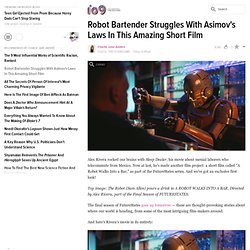
The actual video was a bit less interesting, but still decent and pretty well-made. My original impression got me thinking about other things, though. A Guide to the Job Market in 2034. Whether you're an aspiring lawyer, policeman or programmer, you should be aware that at some point — maybe a decade from now, maybe two, perhaps less — many jobs in those industries will be replaced by an algorithm.
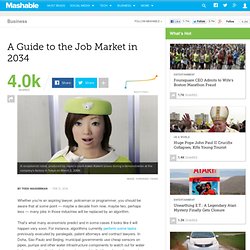
That's what many economists predict and in some cases it looks like it will happen very soon. For instance, algorithms currently perform some tasks previously executed by paralegals, patent attorneys and contract lawyers. As Robots Evolve the Workforce, Will Labor Laws Keep Pace? As Robots Evolve the Workforce, Will Labor Laws Keep Pace?

Every day, robots pop up in more workplaces. Employers in industries from health care to food service are drawn to automation technology by the promise of greater productivity and lower costs. Up to half of the jobs in the United States could be rendered moot in coming years by quickly improving robotics technology, according to an Oxford University study.
The Singularity - 2045: The Year Man Becomes Immortal. Need to Know: Robots down on the farm. On this week's "TechKnow," Marita Davison explores two innovative robots that are helping farms and vineyards change the way they plant and pick their crops.
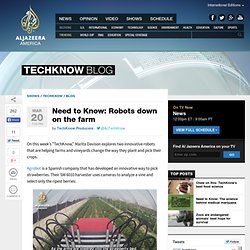
Agrobot is a Spanish company that has developed an innovative way to pick strawberries. Their SW 6010 harvester uses cameras to analyze a vine and select only the ripest berries: The Agrobot makes strawberry picking more efficient, though some human contribution is still required. 10 Jobs That No Longer Exist. Plenty of jobs exist today that didn’t exist 10, 20 or 30 years ago – social media analyst, app developer, etc. – but we’re not exactly awash in jobs, either.

So what happened to all of those old jobs? This list of pictures will go over a few jobs that have gone the way of the dinosaur. A sense of touch makes robots more 'human' A uniquely specialized robot is helping Henry Evans tuck himself in for the first time in ten years.
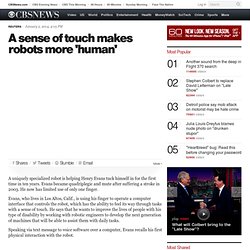
Evans became quadriplegic and mute after suffering a stroke in 2003. This Graph Shows How Likely It Is a Computer Will Take Your Job. As our generation emerges from a recession with over $1 trillion in student debt, we are learning to adapt our skills and values to today's economy, which is increasingly dominated by technology.
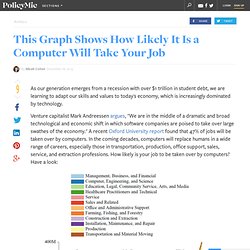
Venture capitalist Mark Andreessen argues, "We are in the middle of a dramatic and broad technological and economic shift in which software companies are poised to take over large swathes of the economy. " A recent Oxford University report found that 47% of jobs will be taken over by computers. In the coming decades, computers will replace humans in a wide range of careers, especially those in transportation, production, office support, sales, service, and extraction professions.
How likely is your job to be taken over by computers? Sztuczna dłoń połączona z układem nerwowym człowieka [WIDEO] NASA JSC Unveils Valkyrie DRC Robot. I, for one, welcome our robotic communist jobless future. Comment Various of the concerned intelligensia seem to be worried at present that the computers and the robots are going to come and take all our jobs.
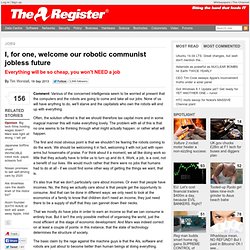
None of us will have anything to do, we'll starve and the capitalists who own the robots will end up with everything. Often, the solution offered is that we should therefore tax capital more and in some magical manner this will make everything lovely. The problem with all of this is that no one seems to be thinking through what might actually happen: or rather what will happen. The Automated Economy. Coffee Haus Kiosk Might Replace Your Barista One Day.
Robots Are Stealing Your Job. McDonald's hires 7,000 touch-screen cashiers. British airports get first holographic helpers. Soft exosuit offers an alternative to rigid exoskeletons. For decades engineers have built exoskeletons that use rigid links in parallel with the biological anatomy to increase the wearer's strength and endurance, and to protect them from injury and physical stress.

In recent years, a number of systems have been developed that show strong commercial potential for helping spinal-cord injury patients walk, or helping soldiers carry heavy loads. In these systems, there is an exoskeleton structure in parallel with the wearer's skeletal structure that is typically connected at a few locations on the body using straps or belts. These devices use motors or elastic materials to assist with joint movements, thereby enhancing human power. However, exoskeletons often fail to allow the wearer to perform his or her natural joint movements, are generally heavy, and can hence cause fatigue.
Potential applications: - Help able-bodied soldiers perform difficult physical tasks. Trans-Humanism / Genetic Modification of all Life / Nano-Technology / HAARP / Geoengineering - Film. El Primer Robot Guardián de Prisión. Una prisión en Corea del Sur está poniendo a prueba el primer guardia robot del mundo desarrollado por el Foro Asiático de las correccionales.
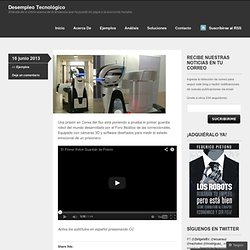
Equipado con cámaras 3D y software diseñados para medir el estado emocional de un prisionero. Activa los subtítulos en español presionando CC. IBM's Watson is better at diagnosing cancer than human doctors. The Myth of Technological Unemployment. In 2012, a lot of firms employed a lot of new labor-saving technology in order to increase profits. That's true. But the same happened in 1992 and 1972 and 1952 and, for that matter, 1852. But whenever you have a prolonged labor market downturn, the salience of this fact increases and you start hearing more and more talk about how there isn't as much need for workers anymore because of mechanization. In the contemporary context, people often use the word robots in this context because mechanization is obviously a trend that's been going on for more than 200 years so robots makes it sound more plausible that something new has happened recently.
But above I have a chart of real output in the United States over the past 10 years compared to aggregate hours worked by nonsupervisory workers over the past 10 years. A Mathematical Proof of the Singularity. The author, inventor and futurist Ray Kurzweil has written about the technological singularity, a time when he predicts things will change so rapidly that he likens it to a mathematical singularity.
In particular, he postulates the invention of an artificial intelligence capable of re-designing itself, which will inevitably lead to ever-faster progress. To back up his theory, Kurzweil likes to show exponential curves representing the ever-faster development of computer processor performance, the price of transistors, DNA sequencing costs and such like. The Scariest Jobs Chart Ever. How Robots Are Changing the Way We Age. When an elderly person needs dinner, “Herb” answers a command given on an iPad.
He heads to the freezer, pulls out a frozen meal, microwaves it and brings it to the person – just like that. What's different about this situation is that Herb is not a person. HERB actually stands for Home Exploring Robotic Butler, and is developed out of Carnegie Melon University's Quality of Life Technology (QoLT) Center. PHOTO GALLERY: 7 Robots That Can Help Aging Americans The center specializes in assistive robots for older adults and people with disabilities. Robots – in addition to other uses – are now being viewed as a way to meet the needs of a fast-growing aging population, with technologies that assist in daily care and provide companionship.
At the same time, health care costs are skyrocketing. THE INDUSTRY LEADERJapan has been leading the way in this field. RELATED: The Rise of Robots – and Decline of Jobs – Is Here U.S. RELATED: 12 Startups Looking to Profit from Aging Boomers. Commercial quantum computer leaves PC in the dust - physics-math - 10 May 2013. For the first time, a commercially available quantum computer has been pitted against an ordinary PC – and the quantum device left the regular machine in the dust.
D-Wave, a company based in Burnaby, Canada, has been selling quantum computers since 2011, although critics expressed doubt that their chips were actually harnessing the spooky action of quantum mechanics. CurvACE gives robots a bug's eye view. The Myth of Technological Unemployment. Credit Suisse Chinese Automation Boom. UNITX - artmarcovici. Droids to replace human workers? The Robot Reality: Service Jobs Are Next to Go. If you meet Baxter, the latest humanoid robot from Rethink Robotics – you should get comfortable with him, because you'll likely be seeing more of him soon.
Rethink Robotics released Baxter last fall and received an overwhelming response from the manufacturing industry, selling out of their production capacity through April. Human or Robot? Harder to Tell In Latest Bipedal Robot PETMAN Video. Robots Will Do Everything You Do Now Only Better—What Then? The S&P 500 is at record highs, having finally regained all it lost in the 2008 financial crisis. Robots Invade Restaurants: Here Are Eight of Our Favorites.
Robot Economy Could Cause Up To 75 Percent Unemployment. Czy ktoś jest odporny na rozwój technologii? Kolejne zawody mogą odejść do lamusa. Robots Will Steal Your Job. DARPA Robotics Challenge Home. Japanese researchers build robot with most humanlike muscle-skeleton structure yet (w/ video) (Phys.org)—Researchers at the University of Tokyo have taken another step towards creating a robot with a faithfully recreated human skeleton and muscle structure. Called Kenshiro, the robot has been demonstrated at the recent Humanoids 2012 conference in Osaka, Japan. Henry Markram: A brain in a supercomputer. Sparaliżowana porusza robotyczną ręką za pomocą myśli. Robot przemysłowy - pomocnik z wyczuciem.